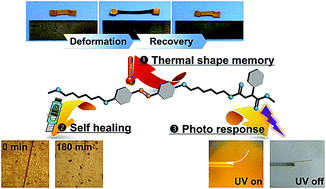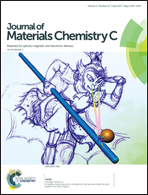Azobenzene-containing liquid crystalline polyester with π–π interactions: diverse thermo- and photo-responsive behaviours†
Abstract
An azobenzene-containing thermotropic liquid crystalline polyester showing unique thermo- and photo-responsive behaviours was synthesized by polycondensation from mesogenic dial 4,4′-bis(6-hydroxyhexyloxy)azobenzene (BHHAB) with 2-phenylsuccinic acid (PSA), and named as poly(4,4′-bis(6-hydroxyhexyloxy)azobenzene phenylsuccinate) (PBHPS). Liquid crystalline behaviours were investigated through differential scanning calorimetry (DSC), polarizing optical microscopy (POM) and wide-angle X-ray diffraction (WAXD). PBHPS showed a smectic phase with strong π–π interactions between the adjacent phenyl rings or between the side group and mesogenic unit, which could be regarded as physical crosslinking points that made PBHPS have good shape memory and self-healing properties. A series of PBHPS/methylcellulose bilayer films were prepared to study the reversible photo-mechanical properties. UV-vis absorption spectra were used to study the reversible photo-responsive behaviour of the polyester, proving that the reversible photoisomerization-induced volume expansion of the PBHPS layer resulted in good reversible photo-responsive properties.



 Please wait while we load your content...
Please wait while we load your content...